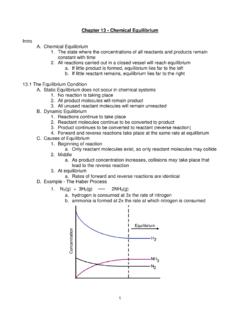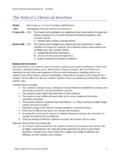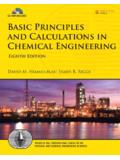Transcription of The Rates of Chemical Reactions - Georgia Institute …
1 Printed April 17, 2000 Chapter TwoThe RatesofChemical ReactionsPage 2-2 Chapter 2 Table of ContentsChapter 2 The Rates of Chemical Observations: Measurement of Reaction of Reactions , Differential and Integrated Rate First-Order Second-Order Pseudo-First-Order Higher-Order Temperature Dependence of Rate Opposing Reactions , Parallel Consecutive Reactions and the Steady-State Unimolecular Decomposition: the Lindemann Acid-Base Enzyme Radical Reactions , Chains and Branched H2 + Rice-Herzfeld Branched Chain Reactions , Mechanisms from Rate Rates of Chemical ReactionsPage 2-3 Figure Concentration of reactant andproduct as a function of 2 The Rates of Chemical objective of this chapter is to obtain an empirical description of the Rates ofchemical Reactions on a macroscopic level and to relate the laws describing those Rates tomechanisms for reaction on the microscopic level.
2 Experimentally, it is found that the rate ofa reaction depends on a variety of factors: on the temperature, pressure, and volume of thereaction vessel; on the concentrations of the reactants and products; on whether or not acatalyst is present. By observing how the rate changes with such parameters, an intelligentchemist can learn what might be happening at the molecular level. The goal, then, is todescribe in as much detail as possible the reaction mechanism. This goal is achieved in severalsteps. First, in this chapter, we will learn how an overall mechanism can be described interms of a series of elementary steps. In later chapters, we will continue our pursuit of adetailed description 1) by examining how to predict and interpret values for the rate constantsin these elementary steps and 2) by examining how the elementary steps might depend on thetype and distribution of energy among the available degrees of freedom.
3 In addition to theselofty intellectual pursuits, of course, there are very good practical reasons for understandinghow Reactions take place, reasons ranging from the desire for control of synthetic pathwaysto the need for understanding of the chemistry of the earth's atmosphere. Observations: Measurement of Reaction RatesOne of the most fundamental empiricalobservations that a chemist can make is how theconcentrations of reactants and products vary withtime. The first substantial quantitative study of therate of a reaction was performed by L. Wilhelmy, whoin 1850 studied the inversion of sucrose in acid solutionwith a polarimeter. There are many methods formaking such observations: one might monitor theconcentrations spectroscopically, through absorption,fluorescence, or light scattering; one might measureconcentrations electrochemically, for example, bypotentiometric determination of the pH; one mightmonitor the total volume or pressure if these arerelated in a simple way to the the method, the result is usually something like that illustrated in Figure In general, as is true in this figure, the reactant concentrations will decrease as timegoes on, while the product concentrations will increase.
4 There may also be "intermediates" inthe reaction, species whose concentrations first grow and then decay with time. How can wedescribe these changes in quantitative mathematical terms?Page 2-4 Chapter 2aNote that both the rate constant and the Boltzmann constant have the samesymbol, k. Normally, the context of the equation will make the meaning of k bB cC dD .( )1cd[C]dt 1dd[D]dt 1ad[A]dt 1bd[B]dt.( )1cd[C]dt k[A]m[B]n[C]o[D]p.( ) of Reactions , Differential and Integrated Rate LawsWe define the rate law for a reaction in terms of the time rate of change inconcentration of one of the reactants or products. In general, the rate of change of the chosenspecies will be a function of the concentrations of the reactant and product species as well asof external parameters such as the temperature. For example, In Figure the rate ofchange for a species at any time is proportional to the slope of its concentration curve. Theslope varies with time and generally approaches zero as the reaction approaches stoichiometry of the reaction determines the proportionality constant.
5 Consider thegeneral reactionWe will define the rate of change of [C] as rate = (1/c)d[C]/dt. This rate varies with time andis equal to some function of the concentrations: (1/c)d[C]dt = f([A],[B],[C],[D]). Of course, thetime Rates of change for the concentrations of the other species in the reaction are related tothat of the first species by the stoichiometry of the reaction. For the example presented above,we find that By convention, since we would like the rate to be positive if the reaction proceeds from left toright, we choose positive derivatives for the products and negative ones for the equation (1/c)d[C]/dt = f([A],[B],[C],[D]) is called the rate law for the f([A],[B],[C],[D]) might in general be a complicated function of the concentrations, itoften occurs that f can be expressed as a simple product of a rate constant, k, and theconcentrations each raised to some power:aThe Rates of Chemical ReactionsPage 2-5H2 Br2 2 HBr( )12d[HBr]dt k[H2][Br2]12( )When the rate law can be written in this simple way, we define the overall order of thereaction as the sum of the powers, , overall order q = m+n+o+p, and we define the order ofthe reaction with respect to a particular species as the power to which its concentration israised in the rate law, , order with respect to [A] = m.
6 Note that since the left hand side ofthe above equation has units of concentration per time, the rate constant will have units oftime-1 concentration-(q-1). As we will see below, the form of the rate law and the order withrespect to each species give us a clue to the mechanism of the reaction. In addition, of course,the rate law allows us to predict how the concentrations of the various species change withtime. An important distinction should be made from the outset: the overall order of a reactioncannot be obtained simply by looking at the overall reaction. For example, one might think(mistakenly) that the reactionshould be second order simply because the reaction consumes one molecule of H2 and onemolecule of Br2. In fact, the rate law for this reaction is quite different:Thus the order of a reaction is not necessarily related to the stoichiometry of the reaction; itcan be determined only by a method for monitoring the concentrations of the reactants and products, howmight one experimentally determine the order of the reaction?
7 One technique is called themethod of initial slopes. If we were to keep [Br2] fixed while monitoring how the initial rateof [HBr] production depended on the H2 starting concentration, [H2]0, we would find, forexample, that if we doubled [H2]0, the rate of HBr production would increase by a factor of contrast, were we to fix the starting concentration of H2 and monitor how the initial rateof HBr appearance rate depended on the Br2 starting concentration, [Br2]0, we would find thatif we doubled [Br2]0, the HBr production rate would increase not by a factor of two, but onlyby a factor of 2. Experiments such as these would thus show the reaction to be first orderwith respect to H2 and half order with respect to the rate law in its differential form describes in the simplest terms how the rateof the reaction depends on the concentrations, it will often be useful to determine how theconcentrations themselves vary in time. Of course, if we know d[C]/dt, in principle we can find[C] as a function of time by integration.
8 In practice, the equations are sometimes complicated,but it is useful to consider the differential and integrated rate laws for some of the simpler andPage 2-6 Chapter 2 d[A]/dt k[A].( )P[A(t)][A(0)]d[A][A] Pt0kdt,ln[A(t)][A(0)] kt,( )[A(t)] [A(0)] exp( kt).( )more common reaction First-Order ReactionsLet us start by considering first-order Reactions , A products, for which the differentialform of the rate law is Rearrangement of this equation yieldsd[A]/[A] = -k [A(0)] be the initial concentration of A and let [A(t)] be the concentration at time t. Thenintegration yieldsor, exponentiating both sides of the equation,Equation ( ) is the integrated rate law corresponding to the differential rate law given in Eq.( ). While the differential rate law describes the rate of the reaction, the integrated rate lawdescribes the Rates of Chemical ReactionsPage 2-7 Figure Decay of [A(t)] for a first orderreaction.[A(t -1/2)][A(0)] 12 exp( k-1/2),-1/2 ln(2)k.
9 ( )Figure plots the [A(t)]/[A(0)] in the upper panel and the natural log of [A(t)]/[A(0)]in the lower panel as a function of time for a first-order reaction. Note that the slope of theline in the lower panel is -k and that the concentration falls to 1/e of its initial value after atime -=1/k, often called the lifetime of the reactant. A related quantity is the time it takes forthe concentration to fall to half of its value, obtained from The quantity -1/2 is known as the half-life of the 2-8 Chapter 2 Figure I* fluorescence intensity as afunction of time on linear (upper) andlogarithmic (lower) krad I h ( )ObjectiveFind the lifetime and half-life of I* from the data given in Figure determine the rate constant krad. Then the lifetime is simply-=1/krad, while the half-life, given in ( ), is -1/2 = ln(2) slope of the line in the bottom half of Figure can be determinedto be s-1. Thus, the lifetime is 1/( s-1) = 126 ms, and the half-life is ln(2)/( s-1) = 87 The lifetime and half-life of I* example of a first-order process is theradiative decay of an electronically excited shows the time dependence of the fluores-cence intensity for iodine atoms excited to their 2P1/2electronic state, denoted here as I*.
10 The Chemical equa-tion iswhere /c = 7603 cm-1. The deactivation of I* isimportant because this level is the emitting level of theiodine laser. Since the reaction is first order, -d[I*]/dt =krad [I*]. From the stoichiometry of the photon produc-tion, -d[I*]/dt is also equal to d(h )/dt, so that d(h )/dt =krad [I*]. Finally, the fluorescence intensity, I, is definedas the number of photons detected per unit time, I =d(h )/dt, so that the intensity is directly proportional to the instantaneous concentration of I*:I=krad [I*]. The top panel plots I as a function of t, while the lower panel plots ln(I) against thesame time axis. It is clear that the fluorescence decay obeys first-order kinetics. The lifetimederived from these data is 126 ms, and the half-life is 87 ms as calculated in Example measurement of the radiative decay for I* is actually quite difficult, and the data inFigure represent only a lower limit on the lifetime.




